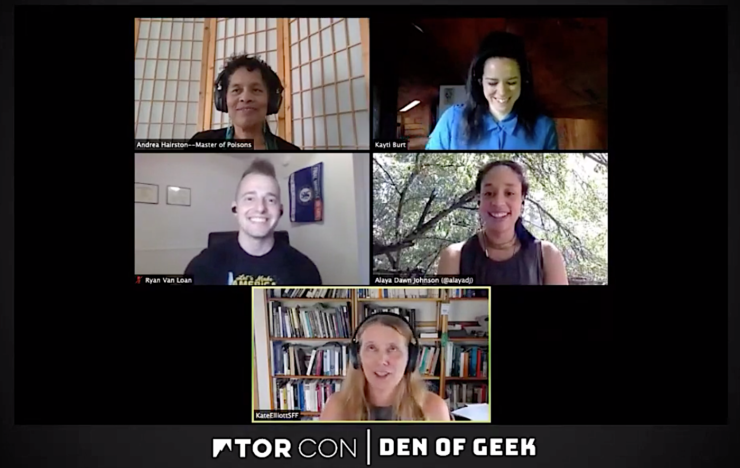TorCon’s Chaos & Cosmos panel celebrated the wilder aspects of storytelling—the stories that refused to end when the crime was solved, the characters who woke their authors up in the middle of the night, and the dream lives of bees. Panelists Kate Elliott (Unconquerable Sun), Andrea Hairston (Master of Poisons), Alaya Dawn Johnson (Trouble the Saints), and Ryan Van Loan (The Sin in the Steel) joined Den of Geek’s Kayti Burt for a lively conversation about the times when stories demanded to be told in new ways.
We’ve rounded up some highlights below!
Kayti Burt started off by quoting Kate Elliot: “I’m the kind of writer who hopes you expostulate angrily out loud on the subway while you’re read, because you’re so aghast at something a character did.” I’m curious, if you’ve had any of those moments as a reader that were formative?
Kate Elliot: As a person raised in a Danish-American household I would never be that publicly expressive? But I’ve certainly cried, I’ve certainly gotten angry. “I’m still made at Ken Liu—he knows why—for something that happened at the end of Wall of Storms. I like being mad! I like being that involved in writing, and in the narrative when I’m reading. It’s what I hope for when I read and what I hope my readers feel that way as well.
Andrea Hairston: Whenever I read Sheree Renée Thomas, she just makes me want to shout. I want to read it out loud. I’m a theater person, and the words are so delicious, the ideas are so interesting, the characters take you out of yourself. I often read things on a crosstrainer, and it’s really boring, but if I have a good book the time just disappears. Sometimes I’m at the gym, and I’ll forget that I’m in a gym, and I’m reading Sheree and I start saying [gesticulating], “Oh, yes! Oh, no no, no she shouldn’t! Wait, yes he should!” so that’s the kind of response that I like. I want to have a conversation with the writer and with the characters.
Alaya Dawn Johnson: I’m a full body reader. I get extremely into what I’m reading, and I remember this would happen to me in high school, I would read books during class, and every once in a while I’d hit point [winces and murmurs as her teens self reading] and the teacher would be like, “Alaya, are you…?” and I’d be like, “Oh, yeah, I’m cool, this is totally my French textbook.”
[All laugh]
There are a lot of these formative ones, I remember in particular, the fourth book in the Vicky Bliss series by Elizabeth Peters, Night Train to Memphis, it has one of these fabulous mid-book reveals that changes how you understand everything that came before, and when writers pull those off, they are my favorite thing, I love them so much, and that’s the kind of thing that makes me jump out of my chair.
KB: Have you ever had those experiences while writing your own things? I think that’s an element of chaos, and I do want to ask you what role you think chase plays in the writing process.
Buy the Book
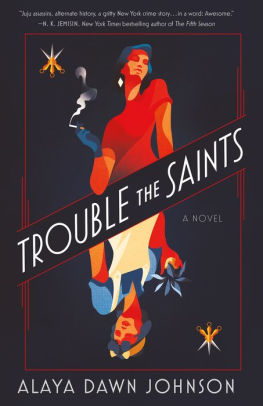

Trouble the Saints
AJD: It’s definitely happened to me. Y’know, it’s a little weird, but sometimes I’ll suddenly realize that one thing connects to another thing, and I hadn’t been thinking about that consciously at all, and when that connection happens—it’s not necessarily when I’m writing it, it’s just that I’ll be working on Plotline A and realize it connects to Plotline B, and it’s overwhelmingly delightful! I’ll run around the house saying “I’m a genius!”
KE: I have exactly the same experience. I couldn’t sit down and plot an entire novel before I write it, I know people who can do that, and do a great job doing it, but for me there’s something about the process of writing where it’s like a physical thing? Physically walking, and going out, and all of the sudden these two things, just like you said, two things that you didn’t know were connected—suddenly you see. Suddenly they meet. and I’s like [dancing] “I’m the best!” But I don’t know why it happens, it’s like a movement thing. Or a physical thing, and it’s the best, I love it when it happens.
AH: I feel like I’m actually possessed by the characters in a story, I don’t feel like I have any control, it like the story is telling itself, and I’m trying to write it well, but any error is mine. But when the story begins to make sense to me because the characters are sitting there “no, no go over there!” and I’m like, OK and over there is a wonderful solution to the problem I’ve been working on—why didn’t I look over there before? But I need my characters to tell me. I really get excited because, like both of you were saying, it’s like my characters are telling me the truth, and there it is, and, “Oh, I’ve already written a whole bunch of stuff that helps that! Oh my god!”
[All laugh]
But then I have to go write the end, and that’s usually what happens, like, “Write the end now, while it’s clear, because you will lose this in about two seconds!” So I rush to write it down, but then it’s like “…how did I do that?”
KB: Ryan, The Sin in the Steel is your first published novel, right? Are there things that surprised you about the process of finishing your first novel?
Ryan Van Loan: I’ve been writing for about ten years. Sin was about the eighth book that I’ve written, and I’ve written ten now. So I had a really well-defined process, and it’s interesting to listen to everyone else—I’m always fascinated by how different writers are with their processes. I’m very much an outliner. I didn’t start that way, my first book I “pantsed” it, but after that I really got into outlining. I like the quote, “The first draft is you telling the story to yourself, and the second draft is you telling the story to the reader.” So for me the first draft is my outline, that’s where I’m telling myself the story. Then the second draft is the prose draft, the one when I’m telling the a story to the reader. I’m a little less intentional, if I’m lucky I’ll get into that flow state where I don’t realize I’m typing, I don’t realize I’m telling the story, I’m just in the story. It definitely doesn’t happen everyday, but when it does, it’s really cool. But the publishing side of things? Working with an editor, someone being able to give you feedback, and tweak things, and take a book that’s good to great—that’s been really exciting.
KB reads an audience question: Who has been your favorite character to write?
RVL: My main character, Buc, she’s been my favorite character to write, she’s very different from me, and I didn’t model her on anyone. That’s the one part of my process that is really organic. Every book idea has been, um, a character voice that’s come into my head, and they start telling me about themselves. So, she woke me up from a dream in the middle of the night, and with the crazy line “If you want somebody to think you’re weak, let the feel empowered and they’ll never see the blade when it’s coming” and I was just like, who is this person? and she took me on a wild ride, and she’s definitely been my favorite character.
KE: It’s kind of like if someone asked “Who is your favorite child?” First of all, they’re all fabulous, but I don’t have a favorite, they’re each different. The character of Mai in the Crossroads Trilogy had a different trajectory, and I wrote her against type. I’m an athlete, and I tend to write physical women, because I don’t think there’s been enough of that in fiction—certainly not when I was first reading. So I wrote her against type. She’s a good bargainer, beautiful and fashionable, and she knows how to get along with people. She’s a savvy negotiator, all things I didn’t have. So I wanted to write her against type and I knew what was going to happen to her, and I ended up falling in love with her as I wrote her. I fell in love with the character, and she’s not based on anybody, she’s just herself, and I ended up doing something I’ve never done in any other book: I altered the plot for her.
AH: I love all my character for different reasons. I think when I was writing Master of Poisons, I’ve had animal characters in all of my books, but in this novel come from the point of view of many. What was really exciting was to be a bee, and write from the point of view of a bee, or write from the point of a river. I wanted to really investigate Nature as subject. Again, I’m a theater person, so a theater exercise would be: “you’re a river” and so it was really fun to use theater to explore what it must be to be a river or a tree or a bee or horses, or whatever. I got to do all of that, and I got to play. It’s like this journey from myself to this other place, that’s what acting is. It was really amazing. And I changed my book because of that. At first I was like, you’re not going to write all these minds? But then they would wake me up at night with their lines! “You want this line? Cause only if you’re in my mind can you use this line.” Only the bee would know what the bee was thinking! So I had to put them in as POV characters.
KB: Now I want a whole panel about things your characters have woken you up in the middle of the night about! Seems to be a common theme.
AH: Bees dream! They’ve done research that bees dream, so that was so exciting to me, like “What are bees’ dreams? What do bees dream about?”
ADJ: I can’t play favorites with my characters, as you all have said, but Trouble the Saints was me trying to stretch myself, I always have pretty strong character-driven novels, but this was the first time I wrote a main character who wasn’t young, she was 35—so she was older than me when I started writing the book, and now she’s younger than me!—what sustained me what the character of Phyllis, who was thorny and knotty and complicated. I was sort of mining weird shards of my personality, and then you kind of figure out how to remix it a little? She’s not like…I’m not an assassin, I have horrible aim, speaking of writing against type, I wrote someone who is extremely good at something I’m horrible at! She’s made very bad choices, like a classic noir hero, and those choices are catching up to her. The reasons why, the world she came from, her family…the thing I loved about writing her was that she has so many layers, and I could tell her story write from her point of view, and then from her ex-lover, and then from the point of view of her best friend, and she’s kind of refracting in the visions of all these different characters, who themselves have their own lives and stories. Her vision of them changes when you can get the story from their point of view, but also the readers understanding of her starts to change? That’s the kind of character work that I’d never done to that degree That’s part of what took me many years and many revisions. I was usually relying more on the external world stuff, and this time it was very much how can I write a character study?
KB: Could you talk about the tension between that may exist between the organic nature of the story you’re telling and transgressing genre conventions? Do you have an example of that? Of a story leading you to a place where you were hesitant to go?
Buy the Book


The Unconquerable Sun
KE: I have an instant one! In Unconquerable Sun—which is gender-swapped Alexander the Great in space!—what happened was that it ended up being multiple point of view, and I knew that was going to happen, but I knew one of the chars had to be in first person. And maybe it was because I’d just written the Court of Fives trilogy, a young adult trilogy where the first person is in present tense, this character’s voice wanted to be in present tense. But then when I needed to write about Alexander the Great analogue, I couldn’t write from her point of view, so she’s written about from third person, but it had to be in past tense, because it’s distanced. So now I had third person past tense and first person present in the same story– and I asked myself, can I do this? Am I allowed? And then two more characters popped in, one in third person past, and one in third person present. And I just had to decide whether I could do it.
AH: Since I come from theater, I don’t know genre rules too well. In theater the big genre divide is between “musicals” and “straight plays”. It’s not so much whether…like Into the Woods is a “musical:, not a “fantasy”—it’s genre is “musical”. You have to create your world, it has to be internally consistent, and the audience has to respond. That’s the biggest rule, and I don’t want to break that! Other than that rule, I feel like I can do whatever works…I had six speaking characters in my first novel, and every character speaks their own reality—however they speak it we have to put it down. I felt like I brought that with me when I started writing novels. And then I found out, well, this is science fiction, this is fantasy – but I don’t really care. Does it work? That’s my rule.
KB: I feel like a lot of those things come in later, because genre is used as a way to explain things to a potential audience.
KE: It’s better to not have to fight your way out of rules that have been imposed—and who know why they’re even there?
AH: Right!
ADJ: I had an experience similar to Kate’s with Trouble the Saints, because I started out with the idea to write a noir story. You start with the crime, and a complicated character, and you see the underworld, and I wanted to look at race and injustice. And I planned it as a novella, as a long short story, and it came out as a 20,000-word novella. It ended where the noir story ended—not to spoil, but it ended where you’d expect a noir story to end. And I was satisfied with that. I kept trying to revise it but at some point, I don’t have character wake me up out of dreams, but these characters just kept talking. They kept telling me more story.
AH: There’s more!
ADJ: And it was weird, because, the story was done! If I keep going it’s no longer a noir story! But it went against every genre expectation, but finally was like, “I give up.” I had to write it, because everything in me needed to know what happens when the violence is done and you have to live with the consequences. That was how I ended up with a three-part structure with three different narrators, who, also the first one’s in first person past, and then there’s a first present, and a third past. The idea was kind of expanding the view until you had a fractalized view of the main character, and it took me places I never expected. I was bowled over by allowing myself to keep going It was definitely me feeling it, you know? Until I realized I had to do something different.
[All nodding]
RVL: I always try to actively avoid tropes. I think the greatest thing about science fiction and fantasy in the last five to ten years is that we’re seeing a lot of new authors coming in with different voice, and we’re losing a lot of those old tropes. The one thing I think I break is the big epic fantasy trope of “the chosen one.” My main character was born on the streets, she doesn’t have a power—no one chose her. She’s chosen herself. She saw something that she didn’t like in her society, and she’s figuring out a way to change it and shoot her shot. When the story starts she’s on her own. Nobody’s shown up on her door to tell her that she’s “special” or that people are going to bow down to her. She has to go make her way in the world through sheer will and grit—and she does.
KE: If I’ve learned on thing it’s that the biggest restrictions are ones I put on myself. And it’s breaking out of those that are the biggest, and most courageous things I can do, is when I think “I can’t do that!” but then I think “Well, why not?” Like Alaya said, “Why can’t I write past a noir?” or like Andrea said, “Why not write with all these different voices?”
KB reading an audience question: What do you know now that you wished you’d known at the start of your writing path?
Buy the Book
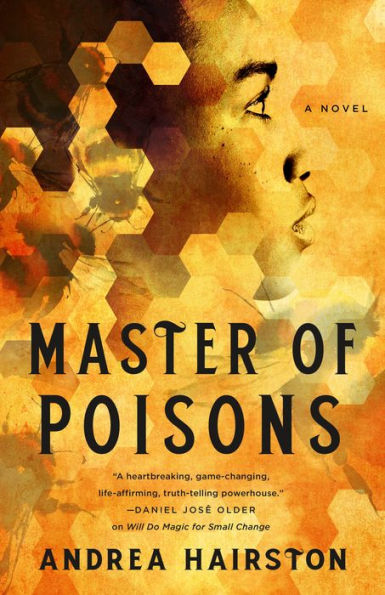

Master of Poisons
AH: Everything I know now is based on where I started, and what I worked through. Even if someone had told me, it wouldn’t have had any impact. I was going to be a physicist, when I was 18. And I liked writing, but I had to find my way to writing. I was like, “I’m going to be a physicist! I’m going to do great things in math!” And everyone wanted me to, I had people supporting me, and I was the first Black woman math textbook editor at Houghton Mifflin! And that was what I was supposed to be doing. When I went back to graduate school in playwriting—everyone supported me, but I had to get there myself. Knowledge is not the same thing as wisdom. I have wisdom now, but I had to live my life to get here.
KE: I completely agree with Andrea, except I wasn’t a physicist, and didn’t do that much math.
KB: You need to learn tings for yourself in a certain order– time travel rules! You can’t break ‘em. Alaya, I’d like to hear more about your system of magic in Trouble the Saints.
ADJ: It came out of deep, deep reluctance to having anything resembling a magic system. Especially in Trouble the Saints, it came out of a need to externalize a reality that’s already present. It’s a light AU New York in 1942, that’s very lightly changed because of this magic system. Some people of color, and some people from marginalized communities, some of them, when they’re around age 11 or 12, a dream comes down to them, a prophetic dream, and what comes with is a power in their hands—a slight uncanny ability. My main character has uncannily good aim, so she uses that to throw knives and kill people. Some people can tell with a touch if someone is threatening them, or tell someone’s deepest, ugliest secret by touching them. I conceived it as a spanner in the works of the white power structure, not enough to overturn it, but enough to turn the tables a little bit, in local context. Over all it’s not enough unless they all banded together, but for various social and political reasons that isn’t happening. Phyllis has used this power to further her own interests, as a woman passing for white in a white power structure. And she’s thought that she was still using it to pursue justice, but she’s beginning to suspect that this was never the case, but that she’s co-opted this gift she was given by her ancestors. It’s a system, and I had to make it make sense. At first it was all about the metaphor, but I needed to ground it a little. The white power structure doesn’t need anything. It’s already there, it’s just tossing a little light on it, to make this real but invisible thing very visible, through the medium of these character who have found themselves able to push back. They’re overwhelmed with a desire to change things, but they can’t so that tension fuels the story.
KB: Andrea, I know there’s magic in Master of Poisons, would you say it’s a magical system?
AH: I never used the word magic, but there are people who understand the relationships between all the elements, and a place you can take yourself, to have visions and discoveries, and then go back to the everyday world and use that knowledge and wisdom. There are capacities people can channel, that are not necessarily in concert with ours. So I don’t use the word “magic” but people can call fire, and there’s a lot of energy around us, so people who know how to do it can can pull energy and use it to make a change for good or for evil or whatever. I think I invented a different cosmology. Not everyone can do it, and there are rules to it, but it’s all part of the wisdom of that world.
KB: Ryan, your story involves dead gods, pirate queens, shapeshifting warlocks, and a Sherlockian teenager. How did you fit all those pieces together?
Buy the Book
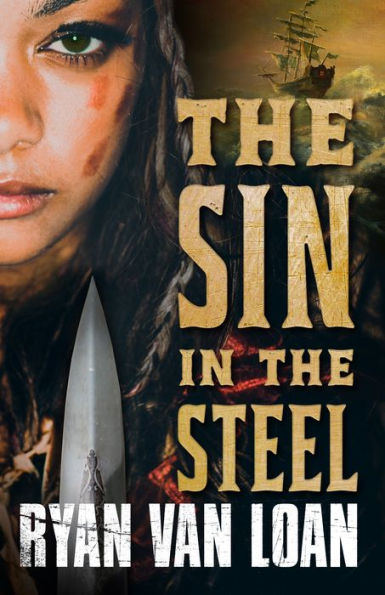

The Sin in the Steel
RVL: I’m a character driven writer first, so in this case it’s anchoring the story in my main character—she’s a street rat, an autodidact, she loves books. When we get to see the world through her eyes, it’s entertaining, but it also helps to grounds everything, and pulls the threads together in a way that makes sense to chaos. But then, is chaos really a bad thing? Who doesn’t love that roller coaster ride when you’re right at the top and about to take that plunge?
KB: Kate, I wanted to ask about Alexander the Great specifically. Why did you choose that historical figure as an inspiration?
KE: When I did a lot of research for Court of Fives, I did a lot of research on Ptolemaic Egypt, which is one of the kingdoms that grew up after the death of Alexander. In the wake of the 2016 election, I was thinking about how much our society struggles with a woman being a charismatic brilliant leader, whose ability to lead is never questioned. And I thought, maybe I want to write that story by gender-swapping Alexander…and putting it in space because then it becomes a space opera. And then letting that character be a woman, because we tend to default that charismatic leader character to men. I wanted to see what would happen if it was a woman. I had to decide is this a patriarchal system in which she has fought her way to become this, but I decided I didn’t want a patriarchal society, because I wanted her to have what Alexander had, which was that no one questioned that he could lead.
KB [with the final two questions from the audience]: One of oldest conventions of storytelling is that it gives order to chaos, how do you keep the possibility of chaos and change alive in a form that privileges order? And how do you create believable chaos?
KE: I try to listen to the voice from my heart or gut that if I listen to it enough I can break away from the rules that constrain me.
AH: I think about improvisation. Improvisation is not chaos, but it’s also not rulebound. There are guideposts, but you’re open to whatever happens in the moment. So you’re ready. Like in contact improvisation, it’s a wonderful physical form where you literally stand and feel gravity you do a “small dance” and you wait for your weight to shift, and go off balance, and you almost fall but you catch yourself, you dance. You have to trust that you’re not going to fall on your face. but you have to go allllll the way to almost falling on your face to find the moment that will surprise you. And that’s where the chaos is…it’s the double sensibility to be willing to go with anything, but to know you have gravity.
RVL: I think in creating believable chaos, it’s what comes before the chaos. Like everything Andrea said, it’s making sure that what you’ve set up makes sense in the internal story you’re telling, and the chaos isn’t coming out of left field. So the reader can understand the world’s components that are at play, and then you can get away with a lot of chaos. You have to do your homework to make sure the reader understands where it’s coming from, that it’s grounded, and then you can break the rules a little bit, in fun ways.
ADJ: There’s a scene in second part of Trouble the Saints, it encapsulates that dance between order and sudden breaking of order. A lot of times the things we see as chaotic are expression of movements and feelings, and kind of bottled up emotions—whether that’s on a societal or a personal level—that are kept under wraps by the weight of the prescribed order of things, but there’s always the tipping point. That is the moment, in a lot of storytelling, that you’re trying to figure out. Especially if you’re trying to create any sort of believability, you have to really show everything that’s been suppressed until that point. Everything that was supposedly kept in an order, that wasn’t orderly but looked like it until it could no longer contain the mass that was boiling up underneath it. Then it comes out however it’s going to come out.
AH: The major thing we have to do is choose perspectives. So the order we see as order is someone else’s chaos. We assume that our conventions are the world. If someone has different conventions then they have a different world. I think one of my tasks as a writer is to help you have multiple perspectives. It can seem chaotic, but we rewrite the cosmos when we reorder the chaos. So if you experience the world from the point of view of a bee, then when you come back to your world is no longer looks the same as it did before.
We’ll leave you with one last shot of the panelists, with a special guest appearance by Kate Elliot’s extroverted Schnauzer, who demanded to be heard:
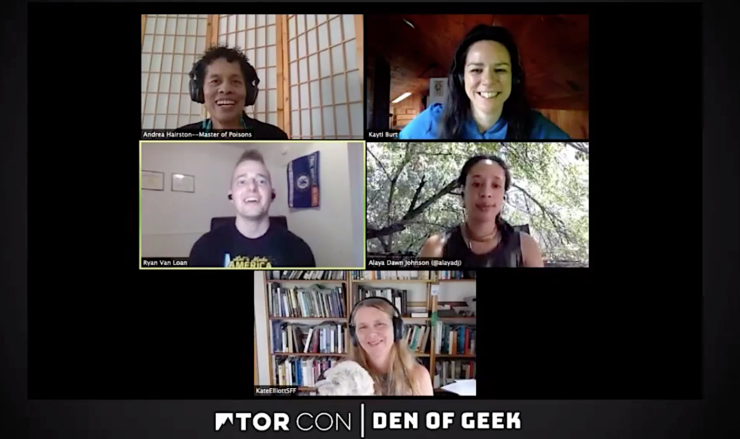
Kate Elliot’s Unconquerable Sun publishes July 7, 2020; Alaya Dawn Johnson’s Trouble the Saints will be out on July 21, 2020; Ryan Van Loan’s debut, The Sin in the Steel, also publishes July 21, 2020; Andrea Hairston’s Master of Poisons will be out on September 8, 2020.










